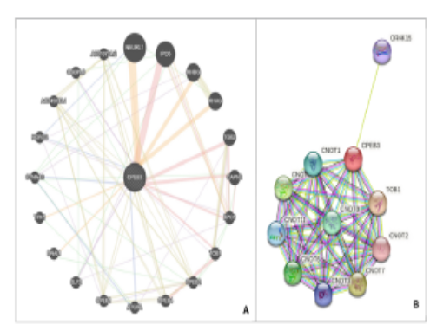


Indian Journal of Science and Technology
Year: 2023, Volume: 16, Issue: 24, Pages: 1795-1801
Original Article
Y Dinesh1*, Karthikeyan Ramalingam2, Pratibha Ramani2, Selvaraj Jayaraman3
1Postgraduate student, Department of Oral and Maxillofacial Pathology, Saveetha Dental College and Hospital, Saveetha Institute of Medical and Technical Sciences, Chennai, India
2Professor and Head, Department of Oral and maxillofacial Pathology, Saveetha Dental College and Hospital , Saveetha Institute of Medical and Technical Sciences, Chennai, India
3Professor, Department of Biochemistry, Saveetha Dental College and Hospital , Saveetha Institute of Medical and Technical Sciences, Saveetha University, Chennai, India
*Corresponding Author
Email: [email protected]
Received Date:11 January 2023, Accepted Date:06 May 2023, Published Date:24 June 2023
Objectives: To analyse CPEB3 using bioinformatic tools in several types of cancer, various HNSCC cell lines based on cancer stages, tumour grades and the gene interaction, protein interaction, regulating pathway, microRNA and survival analysis. Methods: Bioinformatics tools used were UALCAN, TCGA, NCBI, GEPIA, Oncomine, cBioPortal, Human Protein Atlas, STRING, Metascape, miRNA Target Prediction Database. Findings: CPEB3 gene expression was considerably reduced in 520 HNSCC samples. Given that CPEB3 gene expression was downregulated with pathological grading grade 1 (n=62), grade 2 (n=303), grade 3 (n=125) and all 4 stages of HNSCC, this suggests that CPEB3 may be useful for determining the prognosis of HNSCC. CPEB3 gene and protein interaction revealed the high interaction with related proteins. CPEB3 expression in HNSCC causes negative regulation of cytoplasmic translation, cellular response to amino acid stimulus and downregulation of cell population proliferation. Significant low expression of CPEB3 on HNSCC patient survival p=0.013(p<0.05). CPEB3 expression was lower in HNSCC patients with an altered mTOR pathway relative to healthy controls. miRDB results showed miR- 184-5p and miR-21-5p regulate the expression of CPEB3 with corresponding target scores of 98 and 92. Novelty: This study is the first of its kind to utilise bioinformatic tools for analysis of the role of CPEB3 in several types of cancer and its related biological processes. Although there are several in silico studies on cancer, this study has involved several molecular biological processes and its impact on HNSCC. Further molecular studies based on gene knockout studies are warranted to consider CPEB3 as a potential target or a biomarker in HNSCC
Keywords: CPEB; HNSCC; mTOR; microRNA; insilico; Bioinformatics
© 2023 Dinesh et al. This is an open-access article distributed under the terms of the Creative Commons Attribution License, which permits unrestricted use, distribution, and reproduction in any medium, provided the original author and source are credited. Published By Indian Society for Education and Environment (iSee)
Subscribe now for latest articles and news.